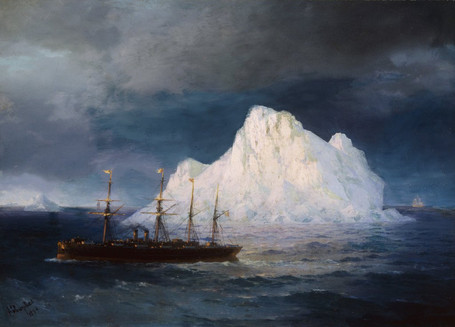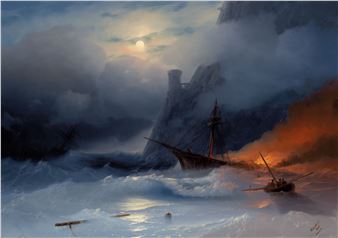Ivan Aivazovsky - Gifted Gallery
- Lilium

- Feb 7, 2021
- 3 min read

Ivan Konstantinovich Aivazovsky, born 29 July 1817, was a Russian Romantic painter of Armenian origin who is considered one of the greatest masters of marine art.
He was born into an Armenian family in the Black Sea port of Feodosia in Crimea and was mostly based there. He was educated at the Imperial Academy of Arts in Saint Petersburg. A primarily Romantic painter, Aivazovsky used some Realistic elements. Peter Leek argued in his book of Russian painting that Aivazovsky remained faithful to Romanticism throughout his life, "even though he oriented his work toward the Realist genre." His early works are influenced by his Academy of Arts teachers Maxim Vorobiev and Sylvester Shchedrin. Classic painters like Salvator Rosa, Jacob Isaacksz van Ruisdael and Claude Lorrain contributed to Aivazovsky's individual process and style. Karl Bryullov, best known for his The Last Day of Pompeii, "played an important part in stimulating Aivazovsky's own creative development," according to Bolton.
Following his education at the Imperial Academy of Arts, Aivazovsky traveled to Europe and lived briefly in Italy in the early 1840s.
He returned to Russia from Europe and was appointed the main painter of the Russian Navy. Aivazovsky had close ties with the military and political elite of the Russian Empire and often attended military maneuvers. He was sponsored by the state and was well-regarded during his lifetime.
During his 60-year career, Aivazovsky produced around 6,000 paintings. However, according to one count as many as 20,000 paintings are attributed to him. The vast majority of Aivazovsky's works depict the sea. He rarely drew dry-landscapes and created only a handful of portraits. According to Rosa Newmarch Aivazovsky "never painted his pictures from nature, always from memory, and far away from the seaboard." Rogachevsky wrote that "His artistic memory was legendary. He was able to reproduce what he had seen only for a very short time, without even drawing preliminary sketches." Roy Bolton praised "his ability to convey the effect of moving water and of reflected sun and moonlight."
Aivazovsky's best paintings in the 1840s–1850s used a variety of colors and were both epic and romantic in theme. Newmarch suggested that by the mid-19th century the romantic features in Aivazovsky's work became "increasingly pronounced." She, like most scholars, considered his Ninth Wave his best piece of art and argued that it "seems to mark the transition between fantastic colour of his earlier works, and the more truthful vision of the later years."
By the 1870s, his paintings were dominated by delicate colours; and in the last two decades of his life, Aivazovsky created a series of silver-toned seascapes. The saying "worthy of Aivazovsky's brush", popularized by Russian playwright Anton Chekhov, was used in Russia for describing something lovely.
Aivazovsky's later work contained dramatic scenes and was usually done on a larger scale. He depicted "the romantic struggle between man and the elements in the form of the sea (The Rainbow, 1873), and so-called "blue marines" (The Bay of Naples in Early Morning, 1898 & 1897) and urban landscapes (Moonlit Night on the Bosphorus, 1894).
The distinct transition in Russian art from Romanticism to Realism in the mid-nineteenth century left Aivazovsky, who would always retain a Romantic style, open to criticism. Proposed reasons for his unwillingness or inability to change began with his location; Feodosia was a remote town in the huge Russian empire, far from Moscow and Saint Petersburg. His mindset and worldview were similarly considered old-fashioned and did not correspond to the developments in Russian art and culture. Vladimir Stasov only accepted his early works, while Alexandre Benois wrote in his The History of Russian Painting in the 19th Century that despite being Vorobiev's student, Aivazovsky stood apart from the general development of the Russian landscape school.
One of the most prominent Russian artists of his time, Aivazovsky was also popular outside Russian Empire. He held numerous solo exhibitions in Europe and the United States. The vast majority of his works are seascapes, but he often depicted battle scenes, Armenian themes, and portraiture. Most of Aivazovsky's works are kept in Russian, Ukrainian and Armenian museums as well as private collections. He remains highly popular in Russia in the 21st century.
Reading Recommendations & Content Considerations
The Paintings of Ivan Aivazovsky by
Gianni Caffiero & Ivan Samarine N.N. Novouspenskii & R. Ware



















































































































































































Comments